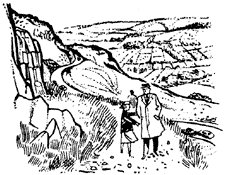
Walks from City Bus Routes
J. R. Carpenter, 2014
Follow the Star of Health.In Theory of the Dérive, Guy-Ernest Debord suggests: “With the aid of old maps, aerial photographs and experimental dérives, one can draw up hitherto lacking maps of influences…” (1958). Following this suggestion, in May 2012, I used the City of Edinburgh Transport Map to undertake a series of walks in and around Edinburgh. However many times I set out in search of the points of interest advertised on the map — The Largest Stock of Hand-Knitted Wollies in Britain, Radiator and Mudwing Repairs and Other Sheet Metal Work, Vertical Filing Systems and Visible Card Index, and Carpenter Joiner Jobbing Specialists, orders in any part of the city or elsewhere in towns or country promptly attended to — dérive led me instead into used and antiquarian print, map and book shops.
Encompass the City.
Map it Out For Yourself.
Do Not Allow Your Holiday to be Spoiled by Rain.
In one such shop I found an A5-sized staple-bound booklet called Walks from City Bus Routes, published by Edinburgh City Transport in the late 1950s. This booklet contains twenty-two walks, each beginning and ending within easy reach of Edinburgh City Transport bus routes. The preface states: “this book is designed for the visitor or the resident who wishes to have a change from the more usual places of tourist interest and to combine a little mild exercise with exploration of the lesser known parts of the city and suburbs.” The unnamed author adds that her one wish “is that those who follow these trails derive as much pleasure from them as she has done over the years.”
In order to reactivate these two historically asynchronous print documents, toward drawing up a hitherto lacking map of influence, I created a web-based computer-generated narrative which uses JavaScript developed by Caden Lovelace to randomly recombine illustrations and portions of text from Walks From City Bus Routes and bus and tram route icons from the City of Edinburgh Transport Map. The term “computer-generated is something of a misnomer here. The computer does not generate new text. It selects phrases from the booklet which I have typed into preset lists (variable strings) and slots them into syntactic templates (sentences). Take, for example, the following sentence:
Take the #{take} and continue #{continue}.I went through the print booklet looking for phrases which follow the words “take” and “continue”. Let’s say the phrases which follow #{take} are:
a ['path leading down the hillside just before the monument', 'path that leads off to the left', 'broad and easy descent down the grassy slope', 'towpath along the side of the park']And the phrases which follow #{continue} are:
['upstream', 'to follow the river', 'in the same direction', 'through the fields', 'as far as the roundabout','along the High Street to the old parish church set in a green graveyard']Here are but a few of the possible sentence results:
Take the path leading down the hillside just before the monument and continue along the High Street to the old parish church set in a green graveyard.Many of the lesser known parts of the city the author of Walks From City Bus Routes urges us to explore are no longer know-able. Many of the green spaces on the City of Edinburgh Transport Map have long since filled in. Stored as variables within JavaScript strings, these past places are ascribed new locations in computer memory. Called as statements into this new narrative structure, these past places become potential places once again.
Take the towpath along the side of the park and continue in the same direction.
Take the broad and easy descent down the grassy slope and continue through the fields.
The result is a new guide ‘book’ which perpetually proposes an infinite number of plausible yet practically impossible walking routes through the city of Edinburgh and its environs, confusing and confounding boundaries between physical and digital, code and narrative, past and future, home and away.
 J. R. Carpenter || bio || digital literature || publications || talks || blog
J. R. Carpenter || bio || digital literature || publications || talks || blog